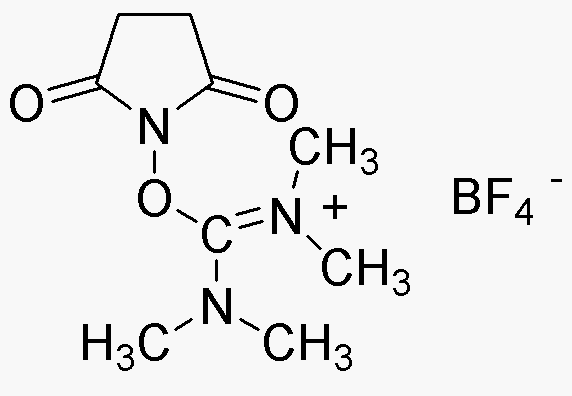2-Succinimido-1,1,3,3-tetramethyluronium tetrafluoroborate is widely utilized in research focused on:
- Peptide Synthesis: This compound serves as a coupling reagent in peptide synthesis, facilitating the formation of peptide bonds efficiently. Its ability to activate carboxylic acids makes it a preferred choice for researchers in biochemistry and pharmaceutical development.
- Protein Modification: It is used to modify proteins for various applications, including drug delivery systems. By enhancing the stability and solubility of proteins, it aids in the development of more effective therapeutic agents.
- Bioconjugation: The compound plays a crucial role in bioconjugation processes, allowing for the attachment of biomolecules to surfaces or other molecules. This is particularly beneficial in the fields of diagnostics and targeted drug delivery.
- Organic Synthesis: In organic chemistry, it is employed as a reagent for the synthesis of complex molecules, providing a versatile tool for chemists looking to create novel compounds with specific properties.
- Research in Material Science: It is also explored in material science for developing new polymers and materials with enhanced properties, contributing to advancements in various industrial applications.
General Information
Properties
Safety and Regulations
Applications
2-Succinimido-1,1,3,3-tetramethyluronium tetrafluoroborate is widely utilized in research focused on:
- Peptide Synthesis: This compound serves as a coupling reagent in peptide synthesis, facilitating the formation of peptide bonds efficiently. Its ability to activate carboxylic acids makes it a preferred choice for researchers in biochemistry and pharmaceutical development.
- Protein Modification: It is used to modify proteins for various applications, including drug delivery systems. By enhancing the stability and solubility of proteins, it aids in the development of more effective therapeutic agents.
- Bioconjugation: The compound plays a crucial role in bioconjugation processes, allowing for the attachment of biomolecules to surfaces or other molecules. This is particularly beneficial in the fields of diagnostics and targeted drug delivery.
- Organic Synthesis: In organic chemistry, it is employed as a reagent for the synthesis of complex molecules, providing a versatile tool for chemists looking to create novel compounds with specific properties.
- Research in Material Science: It is also explored in material science for developing new polymers and materials with enhanced properties, contributing to advancements in various industrial applications.
Documents
Safety Data Sheets (SDS)
The SDS provides comprehensive safety information on handling, storage, and disposal of the product.
Product Specification (PS)
The PS provides a comprehensive breakdown of the product’s properties, including chemical composition, physical state, purity, and storage requirements. It also details acceptable quality ranges and the product's intended applications.
Certificates of Analysis (COA)
Search for Certificates of Analysis (COA) by entering the products Lot Number. Lot and Batch Numbers can be found on a product’s label following the words ‘Lot’ or ‘Batch’.
*Catalog Number
*Lot Number
Certificates Of Origin (COO)
This COO confirms the country where the product was manufactured, and also details the materials and components used in it and whether it is derived from natural, synthetic, or other specific sources. This certificate may be required for customs, trade, and regulatory compliance.
*Catalog Number
*Lot Number
Safety Data Sheets (SDS)
The SDS provides comprehensive safety information on handling, storage, and disposal of the product.
DownloadProduct Specification (PS)
The PS provides a comprehensive breakdown of the product’s properties, including chemical composition, physical state, purity, and storage requirements. It also details acceptable quality ranges and the product's intended applications.
DownloadCertificates of Analysis (COA)
Search for Certificates of Analysis (COA) by entering the products Lot Number. Lot and Batch Numbers can be found on a product’s label following the words ‘Lot’ or ‘Batch’.
*Catalog Number
*Lot Number
Certificates Of Origin (COO)
This COO confirms the country where the product was manufactured, and also details the materials and components used in it and whether it is derived from natural, synthetic, or other specific sources. This certificate may be required for customs, trade, and regulatory compliance.


